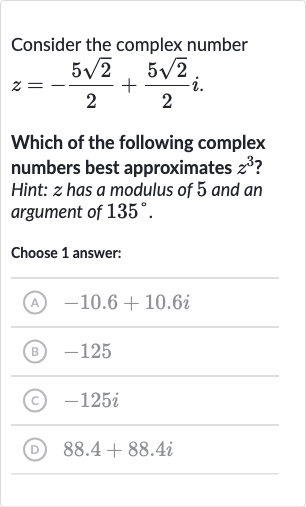Full solution
Q. Consider the complex numberWhich of the following complex numbers best approximates ? Hint: has a modulus of and an argument of .Choose answer:(A) (B) (C) (D)
- Identify modulus and argument: Identify the modulus and argument of the complex number . The complex number is given in the form , where and . The modulus of is the distance from the origin to the point in the complex plane, which can be calculated using the formula .
- Calculate modulus of z: Calculate the modulus of z.The modulus of z is indeed , as given in the hint.
- Determine argument of : Determine the argument of .The argument of is the angle made with the positive -axis. Given that has an argument of degrees, we can use this information directly without calculation.
- Express in polar form: Express in polar form.Using the modulus and argument, we can express in polar form as . For , this is .
- Calculate using De Moivre's Theorem: Calculate using De Moivre's Theorem.De Moivre's Theorem states that . For , this becomes .
- Compute value of : Compute the value of .. Since is equivalent to (as we can subtract full rotations of ), we have .
- Simplify expression for : Simplify the expression for .. Therefore, .
- Calculate real and imaginary parts of : Calculate the real and imaginary parts of . The real part is and the imaginary part is . Multiplying these out gives us .
More problems from Compare linear and exponential growth
QuestionGet tutor help
QuestionGet tutor help
QuestionGet tutor help
QuestionGet tutor help
QuestionGet tutor help
QuestionGet tutor help
QuestionGet tutor help

